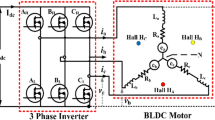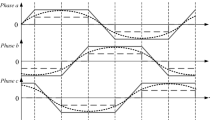Abstract
In the sensorless brushless DC (BLDC) motor control system, the commutation signal is the key to measure the system performance. To improve the commutation accuracy, a commutation compensation strategy based on terminal voltage reconstruction is proposed. By analyzing the commutation process, the integral of ideal terminal voltage is adopted to determine the commutation error. Then considering the voltage clamping of the freewheel diode, the actual terminal voltage is analyzed in different periods. In the non-commutation period, a PWM cycle is divided into three regions, and the corresponding duration can be calculated by floating phase current, and then the equality of actual and ideal terminal voltage integrals is revealed. In the commutation period, the instantaneous value of back-electromotive force (back-EMF) at commutation point is used to construct the ideal terminal voltage and the commutation time is determined by the edge detection. In this way, the integral of terminal voltage can be calculated precisely. Then the error index is introduced and the relationship between the commutation error and the error index is presented. To eliminate the commutation error, the PI controller is adopted which outputs the compensation angle. The proposed strategy avoids the phase shift errors and the accumulation of integral errors, moreover the feasibility and effectiveness are verified by simulations and experiments under different conditions. In addition, the strategy can also be used to correct the installation error of Hall sensor.























Similar content being viewed by others
References
Naseri F, Farjah E, Ghanbari T (2017) "An efficient regenerative braking system based on battery/supercapacitor for electric, hybrid, and plug-in hybrid electric vehicles with BLDC motor. IEEE Trans Vehic Technol 66(5):3724–3738
Park JS, Choi J-H, Lee J (2016) Compensation method of position signal error with misaligned hall-effect sensors of BLDC motor. J Elect Eng Technol 11(4):889–897
Lu S, Wang X (2018) A new methodology to estimate the rotating phase of a BLDC motor with its application in variable-speed bearing fault diagnosis. IEEE Trans Power Elect 33(4):3399–3410
Carlos Gamazo Real J, Jaime Gomez G (2015) Sensorless detection of position and speed in brushless DC motors using the derivative of terminal phase voltages technique with a simple and versatile motor driver implementation. J Elect Eng Technol 10(4):1540–1551
Kim I-G, Hong H-S, Go S-C, Oh Y-J, Joo K-J, Lee J (2017) A study on the stable sensorless control of BLDC motor inside auxiliary air compressor. J Elect Eng Technol 12(1):466–471
Zhou X, Chen X, Peng C, Zhou Y (2018) High performance nonsalient sensorless BLDC motor control strategy from standstill to high speed. IEEE Trans Ind Inform 14(10):4365–4375
Cui C, Liu G, Wang K, Song X (2015) Sensorless drive for high-speed brushless DC motor based on the virtual neutral voltage. IEEE Trans Power Elect 30(6):3275–3285
Lai Y, Lin Y (2011) A unified approach to zero-crossing point detection of back EMF for brushless DC motor drives without current and hall sensors. IEEE Trans Power Elect 26(6):1704–1713
Lai Y, Lin Y (2008) Novel back-EMF detection technique of brushless DC motor drives for wide range control without using current and position sensors. IEEE Trans Power Elect 23(2):934–940
Shao J (2006) An improved microcontroller-based sensorless brushless DC (BLDC) motor drive for automotive applications. IEEE Trans Ind Appl 42(5):1216–1221
Chen S, Zhou X, Bai G, Wang K, Zhu L (2018) Adaptive commutation error compensation strategy based on a flux linkage function for sensorless brushless DC motor drives in a wide speed range. IEEE Trans Power Elect 33(5):3752–3764
Chen W, Liu Z, Cao Y, Li X, Shi T, Xia C (2019) A position sensorless control strategy for the BLDCM based on a flux-linkage function. IEEE Trans Ind Elect 66(4):2570–2579
Bernardes T, Montagner VF, Gründling HA, Pinheiro H (2014) Discrete-time sliding mode observer for sensorless vector control of permanent magnet synchronous machine. IEEE Trans Ind Elect 61(4):1679–1691
Ali N, Rehman AU, Alam W (2019) Disturbance observer based robust sliding mode control of permanent magnet synchronous motor. J Elect Eng Technol 14(6):2531–2538
El-samahy AA, Shamseldin MA (2018) Brushless DC motor tracking control using self-tuning fuzzy PID control and model reference adaptive control. Ain Shams Eng J 9(3):341–352
Potnuru D, Bharani Chandra KP, Arasaratnam I, Gu D, Alice Mary K, Ch SB (2016) Derivative-free square-root cubature Kalman filter for non-linear brushless DC motors. IET Elect Power Appl 10(5): 419–429
Rubaai A, Young P (2016) Hardware/software implementation of fuzzy-neural-network self-learning control methods for brushless DC motor drives. IEEE Trans Ind Appl 52(1):414–424
John Prabu M, Poongodi P, Premkumar K (2016) Fuzzy supervised online coactive neuro-fuzzy inference system-based rotor position control of brushless DC motor. IET Power Elect 9(11): 2229–2239
Hamida MA, De Leon J, Glumineau A, Boisliveau R (2013) An adaptive interconnected observer for sensorless control of PM synchronous motors with online parameter identification. IEEE Trans Ind Elect 60(2):739–748
Li T, Zhou J (2019) High-stability position-sensorless control method for brushless DC motors at low speed. IEEE Trans Power Elect 34(5):4895–4903
Tan B, Wang X, Zhao D, Shen K, Zhao J, Ding X (2019) A lag angle compensation strategy of phase current for high-speed BLDC motors. IEEE Access 7:9566–9574
Liu G, Cui C, Wang K, Han B, Zheng S (2016) Sensorless control for high-speed brushless DC motor based on the line-to-line back EMF. IEEE Trans Power Elect 31(7):4669–4683
Tsotoulidis S, Safacas AN (2015) Deployment of an adaptable sensorless commutation technique on BLDC motor drives exploiting zero sequence voltage. IEEE Trans Ind Elect 62(2):877–886
Song X, Han B, Zheng S, Fang J (2018) High-precision sensorless drive for high-speed BLDC motors based on the virtual third harmonic back-EMF. IEEE Trans Power Elect 33(2):1528–1540
Chen C, Cheng M (2007) A new cost effective sensorless commutation method for brushless DC motors without phase shift circuit and neutral voltage. IEEE Trans Power Elect 22(2):644–653
Lee A, Wang S, Fan C (2016) A current index approach to compensate commutation phase error for sensorless brushless DC motors with nonideal back EMF. IEEE Trans Power Elect 31(6):4389–4399
Chen S, Sun W, Wang K, Liu G, Zhu L (2018) Sensorless high-precision position correction strategy for a 100 kW@20000 r/min BLDC motor with low stator inductance. IEEE Trans Ind Inform 14(10):4288–4299
Chun T, Tran Q, Lee H, Kim H (2014) Sensorless control of BLDC motor drive for an automotive fuel pump using a hysteresis comparator. IEEE Trans Power Elect 29(3):1382–1391
Park J, Lee D (2020) Simple commutation torque ripple reduction using PWM with compensation voltage. IEEE Trans Ind Appl 56(3):2654–2662
Yang L, Zhu ZQ, Shuang B, Bin H (2020) Adaptive threshold correction strategy for sensorless high-speed brushless DC drives considering zero-crossing-point deviation. IEEE Trans Ind Elect 67(7):5246–5257
Chen S, Liu G, Zhu L (2017) Sensorless control strategy of a 315 kW high-speed BLDC motor based on a speed-independent flux linkage function. IEEE Trans Ind Elect 64(11):8607–8617
Li H, Zheng S, Ren H (2017) Self-correction of commutation point for high-speed sensorless BLDC motor with low inductance and nonideal back EMF. IEEE Trans Power Elect 32(1):642–651
Li W, Fang J, Li H, Tang J (2016) Position sensorless control without phase shifter for high-speed BLDC motors with low inductance and nonideal back EMF. IEEE Trans Power Elect 31(2):1354–1366
Acknowledgments
This research was supported by the Open Project Program of Tianjin Key Laboratory of Microgravity and Hypogravity Environment Simulation Technology (Grant no. TJWDZL2019KT009).
Author information
Authors and Affiliations
Corresponding author
Additional information
Publisher's Note
Springer Nature remains neutral with regard to jurisdictional claims in published maps and institutional affiliations.
Rights and permissions
About this article
Cite this article
Li, G., Zhang, T., Li, B. et al. Commutation Compensation Strategy for Brushless DC Motor Based on Terminal Voltage Reconstruction. J. Electr. Eng. Technol. 16, 2031–2043 (2021). https://doi.org/10.1007/s42835-021-00717-5
Received:
Revised:
Accepted:
Published:
Issue Date:
DOI: https://doi.org/10.1007/s42835-021-00717-5




